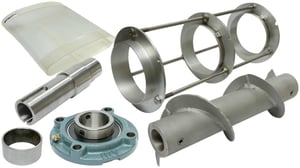Centrifugal sifters, also referred to as rotary sifters or rotary screeners, are a type of industrial screening machine used to process a wide range of free-flowing materials such as powders, agglomerates and granules. Able to perform high-capacity scalping and sifting for both large and small applications, centrifugal sifters are cost-effective, offer increased production efficiency and operate with less noise and vibration than other types of screens, making them ideal for scalping away oversized particles and for removing foreign substances from raw materials. The unique centrifugal action and flexible screen fabric greatly reduce the most challenging blinding problems encountered with traditional screens when processing materials that contain high amounts of moisture, fat or oil.
Sifting Process
The use of a screen, also called a mesh, is an old technique for particle separation (think—panning for gold). Though the process may be old, the technology has steadily evolved. Centrifugal screening is a simple process that separates material based on particle size using centrifugal force. Material is delivered through a vertical feed inlet and transferred horizontally into the cylindrical sifting chamber by an auger. Within the chamber, material is repeatedly accelerated toward the sieve screen by rotating, helical paddles. The rotary action of the paddles generates sufficient centrifugal force on the material to sift it through the apertures of the sieve, where smaller particles pass through and are collected in a large hopper. They also help to spread the material evenly across the screening surface for greater efficiency. In certain applications handling very friable products, the paddles can also break down soft agglomerations. Any remaining oversized particles or foreign material is advanced to the end of the sifting chamber and rejected through a baffle into a separate hopper. This hopper is sometimes fitted with a collection container for capture and inspection of the rejected product where vital for quality control. In summary, centrifugal sifters are able to process a wide range of materials, providing a critical quality control step where removal of off spec particles or foreign material is required.
Application and Benefits
 Centrifugal sifters offer many benefits to the removal of unwanted items or extraneous particles in a variety of ways.
Centrifugal sifters offer many benefits to the removal of unwanted items or extraneous particles in a variety of ways.
In one common application, a client handling material in bulk will often utilize a centrifugal sifter at the discharge of their bulk storage tank or silo. They are also used below intermediate bulk unload points, such as FIBC’s or hand add stations and in some cases right at the entry of a blending process. In all cases, the centrifugal sifter is designed to remove light agglomerates that may have formed in storage or foreign particles, such as paper, string or plastic that may have been introduced during the handling and unloading of the material.This ensures the quality of the raw materials prior to their use in downstream process steps.
In another application, centrifugal sifters are used to screen materials at the end of a process. One such example is in a blend plant, where sifters can remove soft agglomerates and grit, conditioning products as it exits the blender. At the very end of a process, centrifugal sifters are designed to remove off-spec material as a last step before the product is packaged and sold. In both examples, they perform a vital quality control step in a variety of applications.
Centrifugal sifters are used to process a wide variety of products in food, pet food, chemical, pharmaceutical, and other industrial fields. A small sample of the products include flour, sugar, bakery ingredients, grains, spices, lead oxide, plastic powders, powder coating, chemicals, etc.
Centrifugal sifters are critical to many industries. They provide one such solution for the processing of dry, free-flowing materials that require particle separation. Versatile and economical with high capacity in a compact foot-print, Prater centrifugal sifters are ideal for the sifting and scalping of an array of powders, agglomerates and granules.
